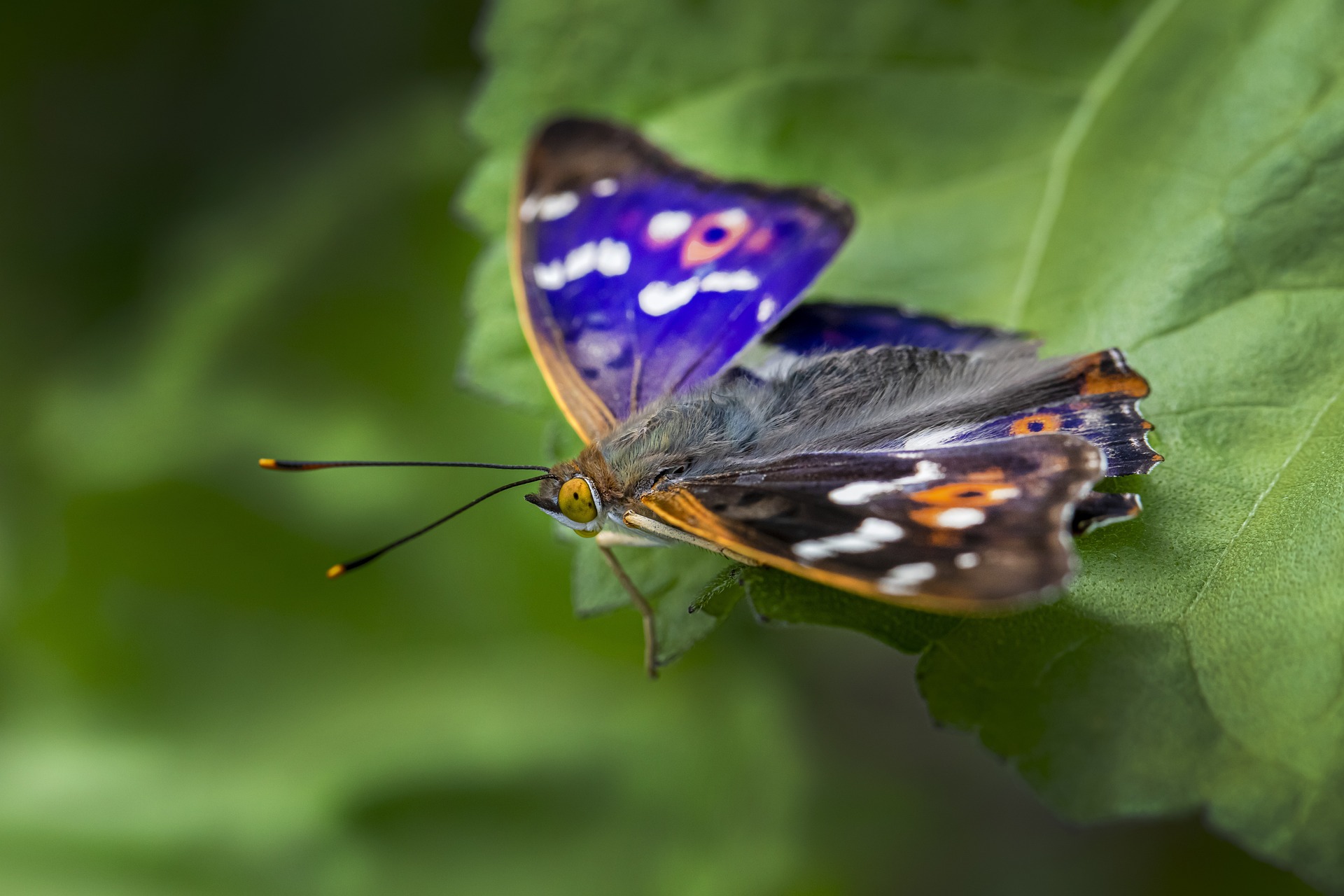Here’s a comprehensive field-guide overview of the Lesser Purple Emperor (Apatura ilia) — one of Europe’s most beautiful and elusive forest butterflies. 🦋👑
🦋 Lesser Purple Emperor (Apatura ilia)
Scientific name: Apatura ilia (Denis & Schiffermüller, 1775)
Common name: Lesser Purple Emperor
Family: Nymphalidae
Subfamily: Apaturinae
Genus: Apatura
🌍 General Overview
The Lesser Purple Emperor is a medium-sized forest butterfly found across continental Europe and parts of Asia.
It’s a close relative of the Purple Emperor (Apatura iris), sharing the same royal sheen on its wings but is slightly smaller and more variable in coloration.
Males are especially striking — when sunlight hits at the right angle, their dark wings flash with a metallic violet-blue iridescence, giving this butterfly its regal reputation.
🧬 Identification
| Feature | Description |
|---|---|
| Wingspan | 55–70 mm |
| Upperside color (male) | Dark brown-black with violet-purple reflection on both wings depending on light angle |
| Upperside color (female) | Larger and browner, without strong iridescence |
| Forewings | Prominent white bands and spots, including one near the apex |
| Hindwings | Orange eyespot with black center near the margin |
| Underside | Richly patterned brown and grey, with a silvery sheen and orange-rimmed eyespots |
| Comparison with Purple Emperor (A. iris) | A. ilia has broader white bands, orange submarginal line, and lacks the purple’s distinct eye spot pattern on the upper wings |
There are several color morphs, including the paler clytie form (found in southern Europe), which shows more orange and less violet.
🌿 Habitat
- Found in deciduous and mixed forests, especially with aspen, poplar, or willow trees.
- Prefers sunny clearings, river valleys, and woodland edges with tall trees for perching.
- Males are often seen basking high in the canopy or descending to the ground to feed on sap, dung, or carrion rather than nectar.
🐛 Life Cycle
| Stage | Description |
|---|---|
| Egg | Small, greenish, laid singly on the upper surface of host leaves |
| Larva | Green with a pair of small horn-like projections on the head and a tail fork; superbly camouflaged |
| Host plants | Mainly willows (Salix caprea, S. alba, S. fragilis) and poplars (Populus tremula, P. nigra) |
| Pupa (Chrysalis) | Green, angular, suspended from leaf stalks or twigs |
| Generations per year | 1–2 depending on region (univoltine in north, bivoltine in warm areas) |
| Overwintering stage | Larva, hidden in bark crevices or leaf litter |
🦋 Adult Behavior
- Flight period: June to August (May–September in southern Europe).
- Males are territorial and often “hilltop” or patrol tree canopies.
- Feeding habits: Rarely visit flowers; instead, they feed on:
- Tree sap
- Rotting fruit
- Dung
- Animal carrion
- Occasionally moist soil for minerals
This non-nectar feeding makes them a challenging but rewarding species for photographers.
🌍 Distribution
- Range: Widespread across Europe, from France and Germany east to Russia and the Caucasus; also found in Turkey, Kazakhstan, and East Asia.
- Absent from the British Isles (except as a rare migrant) and northern Scandinavia.
- Altitude range: Sea level to about 1,500 m.
⚖️ Conservation Status
| Region | Status |
|---|---|
| Global (IUCN) | Least Concern |
| Europe | Common but locally declining due to forest loss |
| Threats | Habitat fragmentation, removal of host trees, pesticide use |
| Conservation | Retention of willow and poplar trees in woodland margins and riparian zones helps maintain populations |
🧭 Similar Species
| Species | Key difference |
|---|---|
| Purple Emperor (Apatura iris) | Larger, darker, with fewer orange markings and different eye-spot pattern |
| Freyer’s Purple Emperor (Apatura metis) | Slightly smaller; found in southeastern Europe; more orange beneath |
| White Admiral (Limenitis camilla) | No purple sheen; lighter, narrower wings; flies in similar habitats |
📊 Quick Facts
| Category | Details |
|---|---|
| Scientific name | Apatura ilia |
| Common name | Lesser Purple Emperor |
| Family | Nymphalidae |
| Wingspan | 55–70 mm |
| Flight period | June–August |
| Host plants | Willows, poplars |
| Distribution | Continental Europe to East Asia |
| Conservation status | Least Concern |
🌿 Interesting Notes
- The purple sheen seen in males results from microscopic scale structures, not pigment — an example of structural coloration.
- Males often descend to forest paths after rain to absorb minerals — ideal for observation and photography.
- The Latin name ilia possibly references a mythological nymph, reflecting the butterfly’s elusive and graceful nature.
Views: 1677
Subscribe to the newsletter:
